Introduction
ARChAEOLOGiCAL records in India and Pakistan before and after 1947 reveal that in addition to many sites distributed along the main course and the tributaries of Indus and Sarasvatī rivers, there were many sites in Gujarat, Baluchistan hills and along Makran coast. Geographical extent of the Indus civilization was vast, sites distributed across an area of 1,600 km from east to west and 1,400 km from north to south. Moheṅjo-Daṛo, Haṛappā, Chanhu- Daṛo, Kālībaṅgan, Banawālī, Lothal, Surkoṭadā and Dholāvīrā are now known as Indus cities designed in a similar way – a citadel, lower town, streets in grid pattern with elaborate drainage system.
Apart from these main centres, a large number of sites were brought into light. In these cities developed many specialized crafts like pottery, clay figurines, seals, tablets, jewellery, ornaments, metal tools, terracotta toys and many other objects. In the last five decades or so archaeologists of India, Pakistan, UK, USA, France and Italy made continuous efforts to unearth more and more material and develop a firm picture of the great culture of that time. An almost continuous sequence of agriculture starting from early farming communities of pre-pottery Neolithic period down to the beginning of the history of India has been obtained.
The Indus Valley civilization did not appear suddenly. It was a long-term development of agricultural societies that had been around there for more than 4,000 years. Agriculture on Indian subcontinent dates to as early as 7,000 BCE. Farming started at Mehrgaṛh located at the foot of Bolan Pass and soon expanded to entire area around the Baluchi hills. Many settlements and cultures developed in and around small river valleys in hilly area and around oases. These farming villages were characterized by material culture such
as pottery, terracotta figurines and personal ornaments. Expanding farming and large growth in production helped in the growth of Indus civilization that succeeded and developed from the earlier cultures, organizing and integrating them.
The Indus-Sarasvati civilization developed from c.2600 to 1900 BCE in north-western part of Indian subcontinent centred around the Indus River Valley. There were many sites in Baluchi hills, along Makran coast, in the state of Punjab, Haryana, north Rajasthan, upper Yamunā plain of Uttar Pradesh, many parts of Gujarat and some parts of Maharashtra. The Indus Valley culture evolved from the earlier cultures after the introduction of Mehrgaṛh. Though this civilization emerged around 2600 BCE, it was in many ways a product of a long-term development of agriculture that had flourished in the greater Indus and upland valley of Baluchistan and beyond for more than 4,000 years.
These farming settlements and culture developed a variety of crafts such as painted pottery, jewellery and clay figurine. Every town produced fine ornaments, seals, tablets, stone and metal objects, pottery and all kinds of terracotta figurines, model carts, toys and many more items.
Many craft specialists produced objects such as pottery, figurines, seals, tablets, jewellery ornaments and metal tools. The development of more sophisticated technology may have played an important role in the formation of Indus culture. In each city are found ornaments, seals, tablets, metal and stone objects, pottery and all kinds of terracotta figurines. Indus culture also produced products such as carnelian beads, gold, bronze, ivory and ebony. These products were provided and processed in Indus towns into objects such as carnelian beads.
Dholāvīrā in Kutch and Lothal in Gujarat were near agate mines used to produce carnelian. The citadel of Dholāvīrā consists of two blocks “Castle” and “Bailey”. The Bailey contained workshops for carnelian beads. Dholāvīrā and Lothal products may have been delivered to other places in the Indus Valley and exported to many parts of West Asia. The Indus people were active trading partners with Mesopotamia and Persian Gulf region. This represents the emergence of a new period, the start of a millennium in which, though there has been a rational growth of some form of art, that art is substantially different in theme and nature as compared to arts existing earlier. This art reached its culmination in or around the year 2000 BCE.
The time limit of 1750 BCE has been adopted because it marks the end of a flow of art and culture in a rational sequence. To quote an example, the pīpal leaf motif which was a dominant motif figuring in pottery and seals gradually disappeared from its prime position, giving place to some other motifs and designs. This was the case with fish scale and intersecting circles also. When Indus civilization collapsed many small villages in Sindh, Punjab and Gujarat continued. Cities were lost but some of the traditions of Indus civilization continued in local cultures that now started to flourish. Nowadays, in India and in Pakistan, one can see remnants of the Indus civilization that was the foundation for all civilizations that spread into the north-western part of the Indian subcontinent.
The timespan for the Indus Valley civilization is 3500 to 1750 BCE. This may be divided this into three groups:
- 6000–2600 BCE – Farming communities and pre-Haṛappan cultures,
- 2600–1900 BCE – Haṛappan cultures, and
- 1900–1750 BCE – Late-Haṛappan cultures.
Material
Material generally found consists of terracotta figurines, jewellery and beads and pottery in early periods. In Mature Haṛappan period, one finds seals, amulets, stone and metal objects, ornaments, jewellery, pottery, etc. A large variety of motifs are seen on seals and pottery.
TERRACOTTA FEMALE FIGURINES
Majority of terracotta human figurines are female, small and simple. The styles and postures of terracotta figurines are somewhat different for each region of the Indus civilization. Before the rise of Indus civilization female terracotta figurines in a variety of shapes and forms were also made in Baluchistan. They were probably used in fertility rituals intended to ensure rich harvest and well-being of the family. Oldest figurines excavated at Mehrgaṛh were simple and unbaked without any description of face. Gradually chest and breasts were added and then hair decoration and other decorations were added. Eventually, elaborately bound and stylized hair and necklaces that cover the upper torso were used as decoration. This trend continued up to 3300 BCE in Gomal plain and Bannu basin. Female terracotta figurines with three-dimensional simple torso, long draped hair and more realistic features with large open eyes and arms, sometimes, holding a child are found.
Female figurines from 2700 to 2500 BCE in Mehrgaṛh and elsewhere had more realistic features. A variety of hairstyles and decorations were found in the female figures during this period. The hairstyle, however, is different from that in the previous period in the sense that all had draped hair rather than the tied-up style and were decorated.
Some figurines have elaborate headdress and heavy-looking ornaments. A large number of ornaments excavated from some Haṛappan sites were found in graves. Ornaments on female figures are often elaborate and heavy looking and covered the head, neck, chest, waist and ankles. In Haṛappan times female figurines from Haṛappā have elaborately detailed headdress, ornaments and accessories. Kālībaṅgan and Banawālī figures are more simply made. Each figurine is different in hairstyle, decoration of head, neck, chest, hips, headdress and belt, which offer a glimpse of the fabulous fashions of 4,000 years ago. Decorations differentiate a common from the elite and the deity. Some figurines may represent local goddesses to whom people offer prayers.
Some are holding a child in their arms or are engaged in some daily activities like grinding grains or kneading bread.
Some female figures were found lying at the bottom of a storm water drain in the castle of Dholāvīrā in Gujarat. This indicates that these images were immersed in water as a part of some ritual.
TERRACOTTA MALE FIGURINE
A male figure appeared for the first time along with female figure in Baluchi hills at Nausharo in 2700 BCE and later in Mehrgaṛh and at Haṛappan sites also. Male figures were usually shown in a standing posture wearing turban, ornaments and other decorative wear. These probably indicate some kind of authority in the society. Some males are depicted in seated posture with their arms encircling their knees.
TERRACOTTA ANIMAL FIGURINES AND TOYS
Cattle, water buffalo, sheep, dog, elephant, rhinoceros, monkey, birds and other animals were represented in the figurines of Indus civilization. Some of them are clear and familiar despite their simple features, but some no longer common may be mythical creatures. The unusual creatures were probably caricatures or representation of humorous character in stories. Terracotta figurines of animals seem to have been toys or offerings. Some animals were made with movable heads, some with wheels, or hollow bodies. Few representations of human and animal figures are closely connected which perhaps reflects the daily life of the people.
CARTS
Terracotta models of cart and plough are found in Haṛappan sites. People may have used their carts to peddle pottery and other goods. Wheels prepared by joining coloured pieces of terracotta was done so cleverly that they looked like wooden wheels. Colour pattern of some of the wheels were made from joined wooden planks. Other designs may have represented spokes. Terracotta models of yokes that would have been used to hitch animals to such carts have been found in Nausharo. They are probably used for carrying load. They are similar to carts and ploughs that are used in villages in India even today.
A model of terracotta plough in almost perfect condition was recovered from the site of Banawālī. The shape of the plough is almost the same as used in modern villages today. It provides evidence that the people of Indus civilization cultivated their fields using ploughs that were pulled by animals. Another evidence of the practice of ploughing is provided by an ancient plough marks discovered at Kālībaṅgan.
TERRACOTTA MASKS
The unusual miniature terracotta masks combine several interesting elements. It seems that they have been a sacred symbol for the people of Indus valley along with the pīpal tree. The holes on the templates indicate that probably these masks were worn as amulets either on upper arms or on forehead, or they may have been used as puppets. Some masks actually could be worn on head and they may have been used in rituals. Small size masks indicate that they were meant for children.

ORNAMENTS
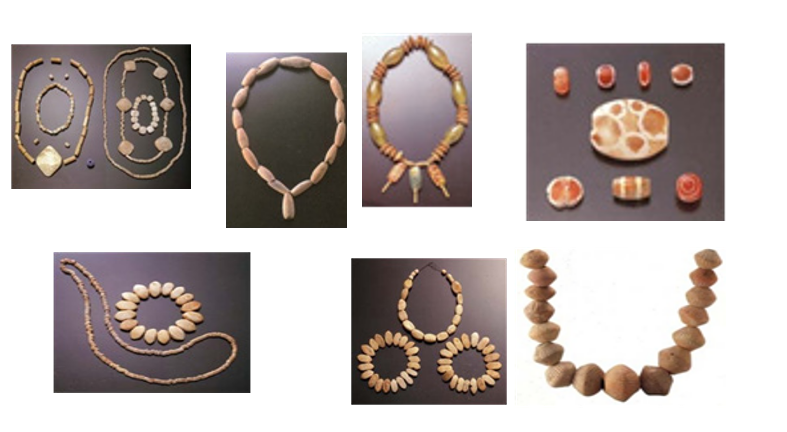
Many types of ornaments were made of stones like agate, jasper, steatite, basalt, shell and terracotta. Ornaments offer a glimpse of the fashion of 4,000 years ago as well as differentiate the people or deities represented. Some figurines probably represent ordinary and some elite women of that time. Some may also represent local goddesses to whom people offered prayers. Wearing ornaments was quite common as can be seen from graves excavated at pre-Haṛappan and Haṛappan sites. Ornaments were mostly for head, neck, chest, waist and ankles. Necklaces of beads of different stones were the most popular jewellery. Beaded ornaments often included more than one large pendant-like stone. Terracotta beads were made before the rise of Indus civilization. These beads were found both in graves and in ancient villages. Terracotta ornaments were probably created as affordable imitations of more valuable or expensive ornaments.
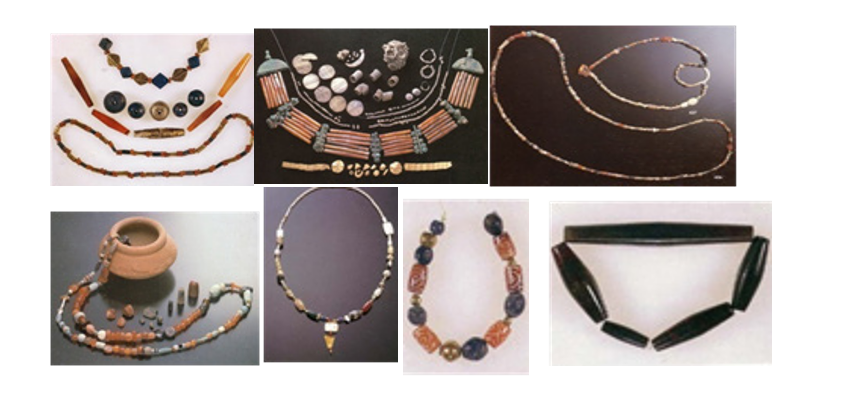
Beads were made from semi-precious stones as also from turquoise, lapis lazuli, carnelian and steatite. Finished products were processed in Indus cities such as carnelian beads. Dholāvīrā and Kutch were near agate mines and they had workshops for carnelian bead processing and producing ornaments. Bones and shells were transported from far-off places like Persian Gulf. Some bangles were made of copper. Some ornaments were designed as brooches, amulets and combs. Indus people wore amulets, probably for protection.
Necklace was made of beads of carnelian and other semi-precious stones. Carnelian beads were made by heating agate to change the colour to deep orange or red and then drilling a whole. Sometimes the length of the bead was more than 12 cm. Carnelian beads especially those with bleached or etched patterns were a specialty of Indus craftsmen. They had been found as far as West Asia.
A unique ornament is a steatite pendant on which a unicorn was carved in relief and some parts were originally inlaid. A tiny carnelian humped bull measuring only 1 cm is another excellent example of Indus craftsmanship Some beads may have also served as amulets.

Apart from semi-precious stones, ornaments were made of other material like gold and silver. They demonstrate considerable expertise of the Indus craft people. Gold items were very rarely found in Indus sites. Necklace and pendants were sometimes made of gold, showing a high level of metal working expertise. A unique double spiral broach required sophisticated craftsmanship as glazed steatite and gold rods were inlaid in a gold frame using resin. The gold objects demonstrate skill and veracity of Indus craft
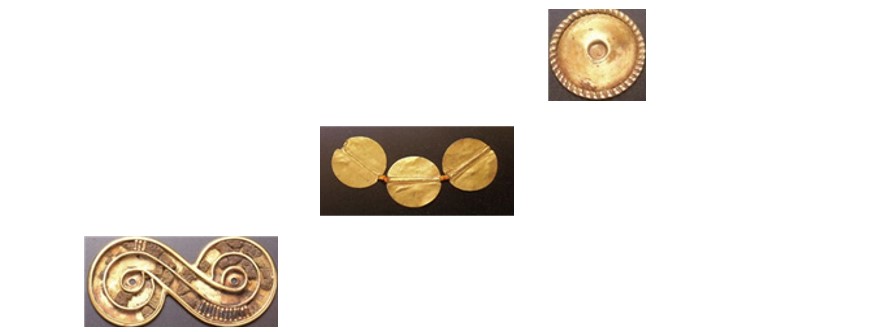
people on a variety of material. Small gold beads are some of the few gold ornaments found in burial belongings to the Indus civilization.

Earrings and bangles and other ornaments often made of faience were also common.

Bangles were made of terracotta faience, shell and copper. Some with intricate designed bangles were made of precious material must have served as special status symbols. Some bangles like amulet may have served a protective function.
Marine shell was a popular material for inlay. Many pieces of inlay in various shapes have been found. It is presumed that these inlay pieces were sewn onto clothing or used as decorations for wooden furniture or set into pilaster walls as decoration The popular shapes were intersecting circles and a heart. Marine shell was brought all the way from the Arabian Sea and was probably considered valuable.

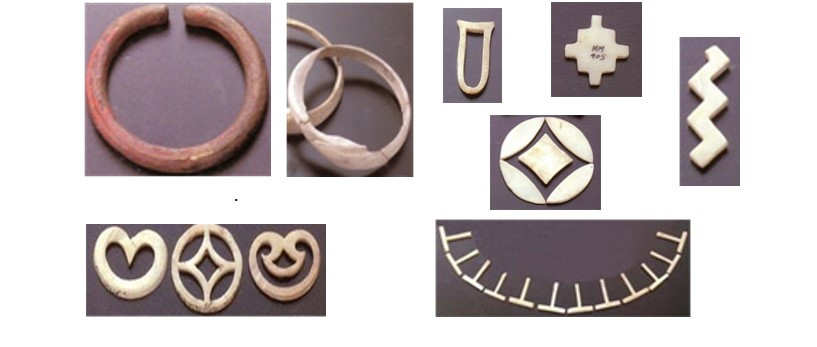
STONE AND METAL SCULPTURE
A limited number of stone sculptures have been found. The limestone sculpture was found either in a sitting posture or sitting with one knee raised shows the most popular posture of sitting. They reflect the keen observation on the part of the artist with great attention to detail and expression in form and posture. A few copper and bronze figurines have been found at Indus sites. All of them are small in size. These figurines are pierced or have a shallow hole on the bottom which indicates that they were worn as ornaments as pin- head decoration or as amulet or pendant worn on the neck.
A few stone figures were recovered from the later period of Moheṅjo-Daṛo and they probably represented very important people or even deities. The surface is highly polished and eyes contain shell inlay which shows a degree of sophistication in figurine art of that times. The steatite sculpture known as the Priest King probably represents a person of very high rank, judging from his elaborate clothing and ornaments. The eyes originally contained shell inlay. The rope may have been blue or green with trefoil pattern filled with red pigment bordered in white. The style of clothing, ornaments, hairstyle and trimmed beard of the figure provides an insight into some of the ancient customs and dress and glooming. A female figure is found with large eyes, hair bound at the back and many bangles decorating her arms and hold a container in her right hand. This small bronze statuette was cast with the lost wax method.
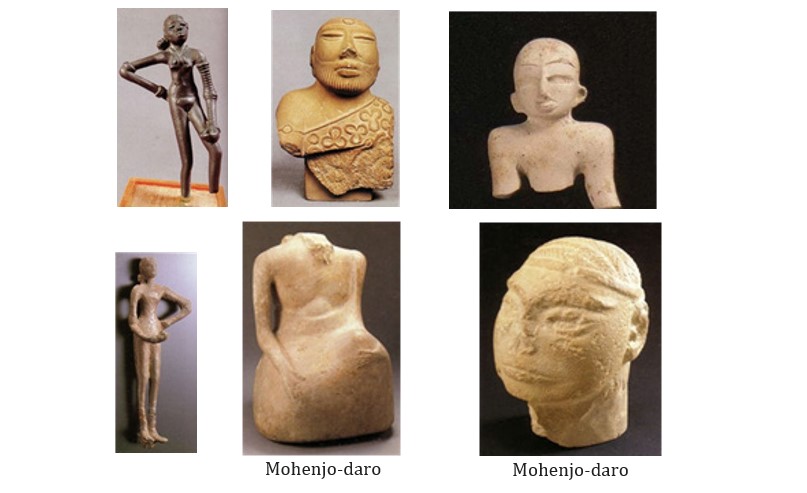
SEALS
Intricately carved seals of the Indus civilization were probably used for trade activities and possibly for other purposes. They were generally in square shape with each side measuring from 2-5 cm. Most seals were engraved with mythical scenes or animals and average of five script signs. The square seals had a small boss on the back of the seal through which a string had been passed allowing them to be worn. Seals were usually made of steatite, but they were also available in soft stones, ivory and even in terracotta. Some
seals identified a select group. Some identified particular individuals. They were a mark of authority and were stamped on belongings of both.
Around 60 per cent of the motifs on seals were unicorn with an offering stand or incense burner in front of an animal. Humped bull, water buffalo and antelopes were quite often shown. Limited seals have the depiction of elephant, rhinoceros, tiger, crocodile or human figures with horned headdress or narrative scenes. Some complex motifs such as buffalo battling with a human or a deity, tiger looking over its shoulders at a human figure probably a deity and an animal with three different heads were also found. Geometric motifs such as cross, svastika and concentric circles had also been found though in lesser number. Horns were apparently sacred to the Indus people. Deities quite often depicted as wearing horn headdress. In some cases, tigers and elephants were depicted with horns on seals. Some seals show fine workmanship of that time.
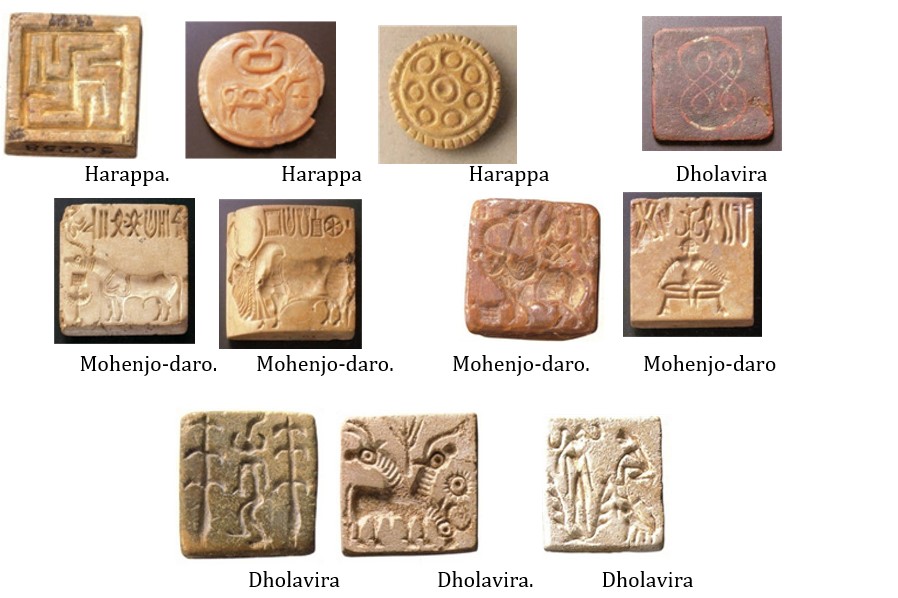
One unfinished steatite seal with a boat is known from Indus civilization; the entire boat is skilfully carved in a small area of 3.5 cm. The boat depicted is high prowled and flat bottom with a central cabin and a large double rudder. This seal may have belonged to a person involved in maritime trade.
Dholāvīrā demonstrates a gradual evolution. The early seals having animals or human figures, mature seals animal with Indus script signs and late seals became rectangular and contains only scripts. Indus script signs also disappeared as the Indus civilization went into decline.
SEALINGS
Sealing is a piece of clay applied to the knotted cord that had been tied around other objects to seal the content. It was a custom in ancient times for the sender to seal a packet or a vessel by stamping a seal; on this piece of clay to show that item had not been opened during transportation. Sometimes different seals were stamped on the same sealing. Terracotta tablets which were also created by stamping or moulding may have been used in trade negotiation as vouchers. Positive impression of negative seals on clay had been found from many sites in fully baked or half-baked condition. The thread impression on the back of some sealing proves that the clay was applied on a knot, probably tied on a parcel or a container and later stamped with the seal of authenticity. Flat tablet sealing may have been used as an identity token.
TABLETS
Several motifs on tablets were probably sacred symbols. Some tablets have narrative scenes with animals and other figures. One tablet has a wheel- shaped sign above a female, probably a deity, holding the necks of two felines and standing above an elephant. Other tablet has a figure surrounded by pīpal leaves on one side and the impression of a unicorn seal – unicorn, offering stand and Indus script signs – on the other side. A three-sided tablet is found at Moheṅjo-Daṛo. All three sides of the tablet were moulded with motifs or Indus script. Motifs included boat, ghaṛiāl (crocodile) holding a fish into its mouth and eight Indus script signs respectively. Ghaṛiāl is associated with the god of water. This may have been used as an amulet or as a token for identification. The depiction of the boat is rare and provides an important evidence regarding navigation in ancient times. The depiction of bird on the boat may provide evidence of the practice of releasing birds from boats in order to judge the location of the land from the open sea.
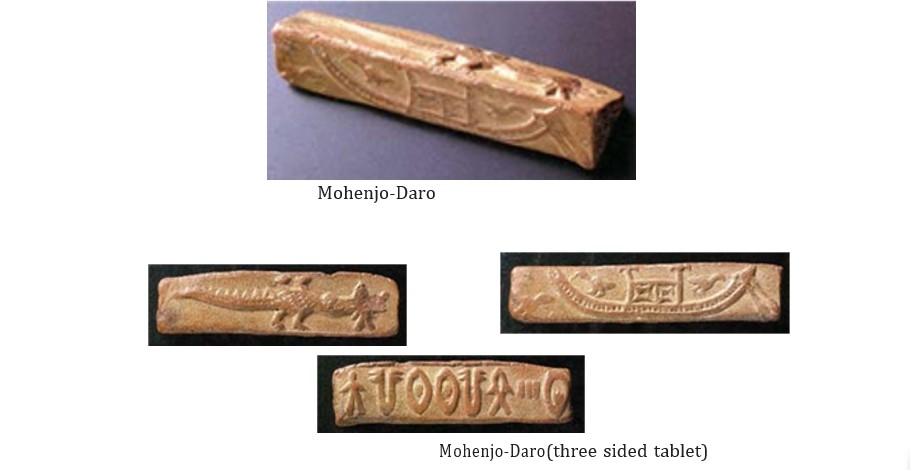
POTTERY
The development of pottery followed the development of agriculture. Pottery made at that time gives us a glimpse of the life. A variety of pottery was found in abundance. It was in different sizes and shapes. Pottery was used for storage, cooking, eating and drinking water. Food was cooked in special- shaped cooking pots and might have been served in plates. Water might have been served in goblets and cups. Most of the pottery was plain but some bear decoration and probably show the status of the people who used them.
The polychrome pottery from the lowest levels at Haṛappā was made around 3300 BCE. The pottery was completely handmade and painted in shades of white, red and black. The pottery of pre-Haṛappan cultures of Sind and Punjab adopted many features from Baluchistan. It seems that it travelled eastward to Kālībaṅgan to become more and more distinct. Some of the range of forms and decorative motifs were derived from Baluchistan. Vessels of soft stone known as chlorite were made in eastern Iran or Bactria and they were often traded over wide distances. Most of the examples date from the second half of third millenium BCE. From early periods to the Indus civilization one can observe gradual changes in form, decoration and development of pottery.
SHAPE OF POTTERY
Different pottery shapes from earliest agricultural culture to Haṛappan levels from many sites were found. The potter’s wheel was used for making most of the pottery that was undecorated. In the early periods, shapes were developed mainly for cooking or for storage. Later, many more types ranging from simple undecorated wares to complicated geometrical patterns, birds and animal designs and multi coloured patterns were made. Just before the rise of the Indus civilization other forms such as bowls and plates on stand were also made.

In the Haṛappan period a variety of forms were expertly made by the local potters for the daily use of the people. Pottery was also placed in graves as offering for the deceased. The forms and decorations of pottery changed over time and some of the changes can be seen in pots from Cemetery H culture.
Drinking Vessels
Small goblets, beakers and tumblers probably were used for drinking water. Small goblet pot with a constricted neck and a shallow pot with sharply carinated shoulder ending in rim are some rare specimens.

Goblet
Goblets appear during 2700–2500 BCE reflect Iranian influence. Southern Baluchistan made barrel-shaped pots of yellow clay with bright red rim decorated with rows of ibex and many other designs were painted in brown. Other characteristic of Baluchistan was decoration on pots with multi coloured designs painted in red ground. Globe-shaped short neck pots from Koṭ-Dījī were characteristic of Early Haṛappan material. Sarāī Khola and Jalīlpur pots demonstrate typical affinities with globe-shaped short neck pots. Short neck pots from Rehmāṇḍherī were common with fish motifs.

Vase
They are met with in red, buff and grey ware, bearing slip in different sites with variation in shape. Some are elliptical and some cylindrical. Some with wide mouth, vase with pedestal base, with narrow base, with re-curved profile, with fluted vase, with wide shoulder, with foot base, with goblet profile or vase bearing knob decoration.

Storage Jar
Various shapes of large jars were probably used for storing grains and water. Storage jars were big and heavy. It was not possible to move them very often. Generally, they have been treated with a creamy or red slip on the exterior. In some, the interior was given a wash. A few jars exhibit paintings. Some of these had been used in burials.
There were tall storage jars with “S” twist. They were invariably treated with a red slip on the interior and were generally painted in vertical and horizontal registers with geometrical floral and faunal designs.
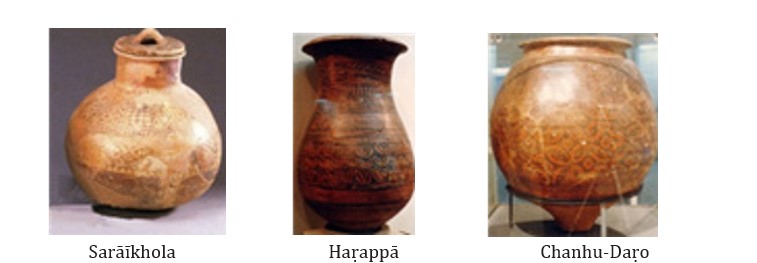
Dish or Plates
Dishes are squat, open vessels made of medium to fine clay, very often treated with red or creamy slip, invariably on the inside and outside. Sometimes they were painted inside also. Large plates from early periods to later periods show gradual change in form and decoration taking a form of dish on stand.

BOWL
Bowls are found in different shapes and sizes. Certain style of bowls can also be traced back to the beginning of the third century BCE. Cylindrical bowls with low outward bases and deep bowls are among the common form. The bowls fall into the following types: convex sided, short stemmed, stud handed and carinated.

HĀNDĪ
It is a common pot of similar shape found throughout the period. In the
Haṛappan period hāṇḍīs bear a ridge on the shoulder. But the distinguishing feature of these is the application of bichrome slip. The slip above the ridge is dark and a combination of dark red with pink or chocolate with cream.
CUP AND CUP-ON-STAND

Cups are found at Jalīlpur, Koṭ-Dījī and Moheṅjo-Daṛo while cup-on-stand is from Dholāvīrā and Kālībaṅgan.
BASIN
Basins are found in different shapes and sizes. Some of them are painted.
CASKET
They were made of fine clay mostly slipped and painted. Usually found with lids.
RING STAND
Pottery rings used to hold large vessels are usual Haṛappan elements. Mostly found on Haṛappan sites, wheel turned, sturdily built used to provide firm foot long and stability to the huge jars or other similar vessels. Generally treated with wash or slip of cream or red colour.
LId

Lids are mostly found in different sizes and some are handmade and some wheel-turned. Mostly they are plain, but some bear linear painting on the side.
LAMP
Terracotta lamps filled with oil were surely used for light. Examples are available from Nal, Haṛappā and Lothal.

BOTTLES
Bottles probably had been used for cosmetic use. The forms and decoration changed over time.

Water or Oil Vessels
Water vessels are found in all sites with various shapes and sizes. Some vessels from the Indus civilization
, covered with black slip from both inside and outside, were to carry liquids such as oil or alcohol for export. Indus script signs were carved on shoulder or bottom of each jar. This might have served as a way of labelling the jar with the name of person or organization that sent or received them.
Bottom of the large vessels was first made with a mould and then sides of the vessels were built up slowly from this base on the wheel. The motifs generally were pīpal leaves, peacock, fish scale and other geometric motifs in black-on-red slip.

Ground Colour
The ceramic contents may be divided into:
- Light terracotta red,
- buff,
- red,
- black and red, and
- grey
Light terracotta red and buff wares are mostly found in the pre-Haṛappan period. Black-on-red ware was commonest pottery in Haṛappan times. The
late Haṛappan period witnessed black-on-red and grey wares too. The wares without exception are found in two fabrics, fine and coarse.
The slip, in a large number of potteries, is absent. The most common slip, when present, is red. Others range from whitish to yellowish hues, chocolate or purple. A few specimens show the use of double slip, viz. red and creamy, red and chocolate or creamy with chocolate. Creamy and purplish slip is rarely met with, and this also applies to the black slip on grey wares.
Both bichrome and monochrome wares are present. The paintings occur in black, black/white on red surface, chocolate/white and purple/black on the buff surface and white and creamy on black surface. The grey wares do not bear paintings. The pottery exhibits red and creamy colours but is rarely purple.
Patterns
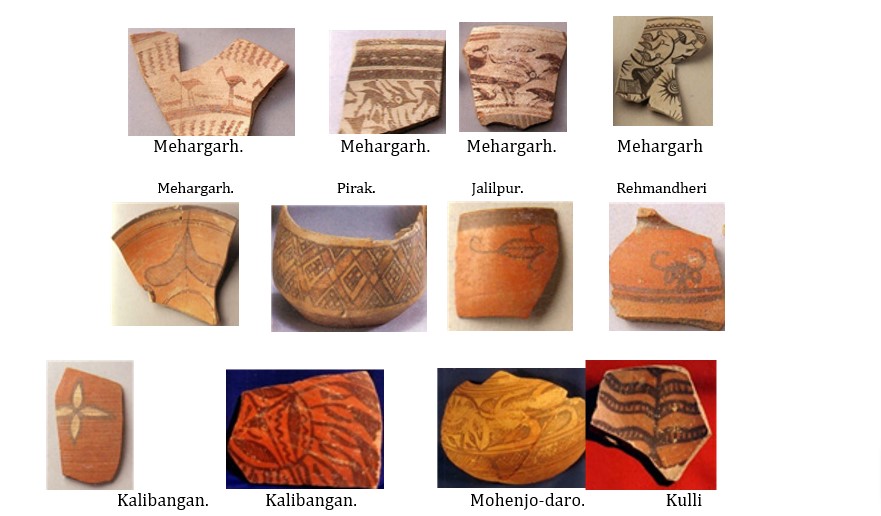
Most pottery found in the region is unpainted, i.e. plain. The painted pottery constitutes a very small percentage of the total ceramics. Painted motifs prior to the Indus civilization were found in many areas. The painted pottery shows the potter-painter’s predilection for geometric designs. Naturalistic patterns are also depicted, the theme being flora and fauna of contemporary times.
Between 3500 and 2300 BCE, a new type of polychrome pottery appeared with square and triangular geometric patterns on outside surface of a vessel, painted in red, black and white. Painted grey ware, abundant in the first half of the third century BCE, were well fired pottery decorated with geometric patterns, and fish and animal patterns. Barrel-shaped pottery made of dark yellow clay with bright red rims decorated with row of ibexes painted in brown, multi coloured designs and Togau geometric patterns which are painted in red on pots. The pīpal leaf pattern, flying birds, wild donkeys and horses are seen as early as 3000 BCE at Mehrgaṛh.
In south Baluchistan from 2800 to 2500 BCE, red pottery typical of Indus Valley civilization is evidenced in the earlier phases of Amrī. The globe- shaped short necked pot from Koṭ-Dījī is characteristic of early Haṛappan material culture. Horn with flower probably represents a deity, painted below the neck of red pot painted with black. Two short-necked painted pots found at Jalīlpur with a black band from neck to shoulder demonstrate affinity with short-necked pot of Koṭ-Dījī. Horn deities were painted on short-necked pots found in Saraīkhola, Rehmāṇdherī and Jalīlpur. Fish motif was also quite common in this period. The pottery from Nindowarī and Kullī in southern part of Baluchistan prior to and contemporary with the Indus civilization had motifs such as pīpal leaves, gazelles, humped bull and fish scale, and intersecting circles are usually painted on red with black colour. These were the characteristics of southern Baluchistan.
Pottery found in rural sites is quite mature and well developed in its own style. Its most characteristic and distinguishing feature lies in the beauty and delicacy of its forms and decoration which is neither overcrowded nor scanty or merely conventional. Here the faunal world is held apart from that of the floral, and these two, from the geometrical. At these sites, even simple bands were drawn carefully and were rich in imagination, which make them extremely effective. At some pre-Haṛappan sites like Amrī, Koṭ-Dījī and Kālibaṅgan, Haṛappan motifs are observed in the last phase of their culture. At other sites, Pre-Haṛappan pottery marks an evolution within the rural sites.
The pottery of Haṛappans is so distinctive that it stands out clearly from those of the earlier periods. The most popular design of these sites is the pīpal leaf, intersecting circles, fish scale, checker pattern, comb and some floral designs. Among birds and animals, peacock, snake, fishes, ibex, deer and goat may be mentioned. Indus people had reverence for bull and pīpal leaves. In early period, head of the bull was drawn. Immediately before the Indus civilization, animals were most frequently depicted. The bull got changed into water buffalo and horns were drawn symbolically.
The presence of the ibex in some sites of the Indus Valley indicates contact with the sites further west. Human figures do not occur except at one or two instances in Haṛappā. Paintings generally occur in registers or zones which normally do not reach below the waist of the vessel. Wholly painted pots are also found in the Haṛappan period. Here the faunal, floral and geometrical world mingled. The design painted on some vessels seems like scenes from a story and may indicate that it had some ritualistic use. A variety of motifs has been found on Haṛappan pottery.
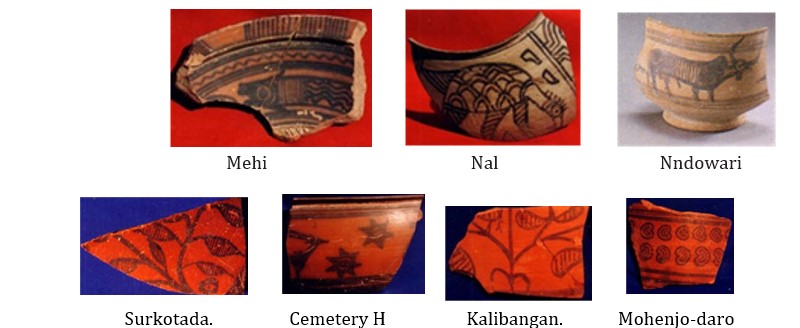
Apart from the habitational area, some painted sherds have been found from burials also, i.e. Cemetery H and Shahi Tump. They exhibit a variety of designs including animal, plant, leaf, star and sun motifs. Among the secondary motifs, the goat with long wavy horns and the peacock are worthy of mention. Among the secondary motifs as fillers of empty space – fish, star, wavy lines and linked pīpal leaves are observed. Geometrical designs consist of rays, orbs, stars and tassels, while plant life is represented by pīpal in a variety of combinations and the date palm.
The paintings which occur on the burial urns of Cemetery H are not merely decorative but also convey a deeper significance. They reflect popular beliefs regarding the fate of the dead. There is no doubt that these people believed in the continuity of life after death.
Summing Up
The first agricultural community started at Mehrgaṛh as early as 7000 BCE. Soon after, other cultures also emerged and all got amalgamated with one another. This resulted in the making of the Great Indus civilization which reached its climax 2600–2000 BCE. They developed some ideologies and lifestyles that are continuing even today. While the Indus civilization collapsed and cities lost, yet those traditions continue as local cultures. The ideologies and lifestyles were so fundamental to human existence that they cannot die. They have played an important role in shaping the culture in the subcontinent as it is today.

